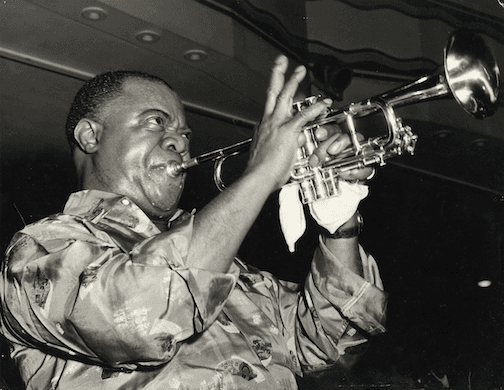Louis Armstrong: The Greatest Artist of the 20th Century
After watching ‘Louis Armstrong’s Black and Blues,’ see if you would be able to find an argument to deny Satchmo the crown.

In reviewing a boxed set of Louis Armstrong recordings released in 1994, “Portrait of the Artist as a Young Man: 1923-34,” a music critic then writing for the Village Voice, Robert Christgau, indulged in a challenging bit of critical hierarchy: After positing Armstrong as the greatest artist of the 20th century, Mr. Christgau asked, “Who else you got? Picasso, Joyce, Renoir, Elvis?”
Each of us can come up with our own choices, of course: I’d put Henri Matisse in the mix while others might pick, say, Charlie Chaplin, Virginia Woolf, or maybe T.S. Eliot. After watching “Louis Armstrong’s Black and Blues,” though, I think most would be disinclined to argue against Satchmo being crowned the greatest artist of a peculiarly troubled century.
Every century is peculiar and troubled in its own way, of course, and “greatness” is a quality that has undergone discussion, definition, and realignment since Day One. Yet Armstrong’s accomplishment, like that of any significant artist, reaches beyond the parameters in which it originated. In many respects — not least, his boundless humor, downhome sagacity, and good will — the 20th century can barely contain him.
Consider the obstacles a black man born in the American South in 1901 had to overcome. Then take into account the stratospheric heights that same man reached. “American exceptionalism” is a notion much in dispute and, in some quarters, held in permanent suspicion, but if there’s one figure who embodies that ideal, it is the gravelly voiced trumpeter who made his home at Corona in the New York City borough of Queens.
The producer and director of “Black and Blues,” Sacha Jenkins, has culled a tremendous number of resources to limn Armstrong the man, as well as to elaborate on how he became a towering icon and, at moments, a figure of approbation. These include TV appearances, snippets from movie musicals, concert footage, home movies, scrapbook pages, audio interviews, and never-before-heard recordings wherein the inventor of jazz lets loose with invective that wouldn’t have made it within a country mile of “The Ed Sullivan Show.”
A fascinating current of “Black and Blues” underlines the vexing relationship that can accrue between international celebrity and private citizen. Armstrong steered clear of politics — “I just blow my horn,” he stated famously — but the civil rights era put paid to his silence as a public figure. Armstrong had choice words about President Eisenhower’s handling of school integration, just as radicals in the 1960s had choice words about Armstrong as a cultural lodestar.
“Sellout” was only the mildest of epithets he endured from that crowd. Mr. Jenkins frets that Armstrong may still be perceived as an “Uncle Tom … who would do anything to be in favor with the oppressor, the white man.”
It’s not hard to commiserate with that opinion, given the cringe-inducing segment we see from the 1931 short “A Rhapsody in Black and Blue” — in which Pops and the band are clad in jungle attire and playing amidst a field of bubbles. Surely, though, we sophisticated 21st century types can take into account shifting cultural mores and, especially, how Armstrong transforms “Shine” into an irrepressible avowal of racial pride. Ideologues are never good with paradox.
“Black and Blues” is peppered with nods to Armstrong’s idiosyncrasies — including his dependence on Swiss Kriss, the “anti-spasmodic” herbal laxative. Mr. Jenkins livens up the proceedings by animating the cut-and-pasted illustrations with which Armstrong decorated his voluminous diaries. All the while, Louis Armstrong — the complicated man, inescapable myth, and incomparable mensch — is given his due. That alone counts as a blessing.
______________
Correction: Armstrong was a trumpeter. An earlier edition misstated his instrument.

